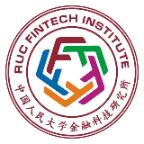Decentralized Finance: Explore Blockchain Technology and Open Debt Consolidation
The Stevens Institute of Technology published an article titled "Decentralized Finance: Exploring Blockchain Technology and Open Financial Systems" which explores the business model and constraints of the financial division.
introduction
Blockchain technology can reduce business costs, facilitate business integration, and build trust, thereby laying the groundwork for new business models. In the financial sector, blockchain technology supports the development of more efficient, innovative, interconnected, borderless and transparent financial services. Unreliable financial services can reduce exchange rates, expand financial integration, promote open access, encourage illegal reforms, and create new opportunities for consumers, entrepreneurs and new developers. This series measures the benefits of financial management, identifies existing business models, and measures challenges and constraints. As a new finance industry, the real estate industry can transform the modern economy, create a new environment for business and innovation, and show the potential of decentralized marketing as the basis for new business models.
The result of decentralized finance
Employees often play an important role in reducing and increasing exchange rates, as they can help the parties to the exchange find competitors, build trust, and solve industries' problems (Roth, 2015) . Financial instruments have reduced the demand from financial institutions to some extent. Fintech can improve the functionality of existing financial services and facilitate the introduction of new financial transactions such as peer-to-peer payments, loans, and financial services (Lee & Shin, 2018). ). However, fintechs do not generally eliminate all intermediaries from the stock market, but instead exchange intermediaries (e.g. financial firms) with other intermediaries (e.g. technology company). Today, even if it is a company that uses financial instruments, most financial markets still require the involvement of a central organization, which is at the base of the pressure to trust market players. the exchange and functionality of the digital platform. Blockchain technology and financial management may be the next step in this process.
The recent development of blockchain technology creates new concepts that can bring distribution and distribution. Because blockchain technology enables the creation of trust and integration, blockchain can eliminate the need for intermediaries to support financial transactions. Thus, blockchain technology can reduce trading costs, expand business, and replace existing business models that are detrimental to business models. With the help of blockchain technology, financial services can become more marketable, innovative, collaborative, borderless and transparent.
The advantages of decentralized finance
1. Decentralization
In a decentralized financial system, financial transactions can be carried out easily through a decentralized peer-to-peer network rather than through a centralized institution. By reducing the involvement of centralized organizations, joint ventures can reduce exchange rates while creating a mutually beneficial partnership. impact the monopoly value (Catalini and Gans, 2019). The reason is that no business can be independent enough. The power of evil against others (Huberman, Leshno & Moallemi, 2019).
2. Innovate
Decentralized platforms allow new developments without authorization due to lack of party control. This means that developers are free to develop and experiment with new applications without permission (Cerf, 2012; Chesbrough and Alstyne, 2015).
3. Cooperation
Decentralized finance is created by opening up the blockchain and opening models to integrate multiple services. A high level of collaboration allows capital and value to flow to a wide range of different services and regions, thus creating the Internet of Things (Antonopoulos, 2016).
4. No borders
Decentralized finance has no borders because it has nothing to do with geographic area or legitimate benefits.
5. Transparent
Decentralized financial protection protects the public ledger through decentralized approval and sweeping transparency. It uses a public list that can be easily accessed and identified, and logs changes on the public blockchain to prevent malicious behavior.
Important business models of decentralization

Figure 2: Increased investment in blockchain
1. Decentralized currency
Bitcoin is the first decentralized cryptocurrency, provided by distributed technology without being issued in a single country (Nakamoto, 2008). Unlike the existing profits of mid-sized banks, Bitcoin's supply strategies are fixed and cannot be traded on demand, so they have a hedge against inflation. Given the decentralized nature of Bitcoin, it has become a key market of value for the blockchain industry, commonly referred to as digital gold (Popper, 2015).
2. Health insurance
Centralized payment networks like Visa, Mastercard, and PayPal support both online and offline transactions, but their services typically charge higher fees. Decentralized payment networks such as Libra (Libra Association, 2019) and Bitcoin Lightning Network (Poon and Dryja, 2016) promise to provide immediate, low-cost international health insurance solutions to address issues with existing plans.
3. Decentralized finance
Blockchain technology is changing the financial landscape (Chen, 2018; Fisch, 2019). One of the most important documents in financial management is the initial issuance of coins. In an ICO, projects create tokens as a special function of the public blockchain and sell tokens to potential investors to fund their initial development.

Figure 3: Result of ICOs and the release of ICO tokens
4. Decentralized contract
A smart contract is “a function that works well in an emergency (eg, a law) before the contract is honored” (Murray et al., 2019). Smart contracts must reduce the complexity and cost of contracts due to their transparency, flexibility, automation and programmability. Contracts successfully extend the scope of contracts, reduce costs, and support innovation and innovation.
obstacles to overcome
Decentralized finance faces a variety of issues related to fraud, ease of use, inaccurate and imprecise management.
First, financial management has been implicated in the spread of fraud and illegal financial transactions, which can lead to financial risks. Decentralized financial services allow unauthorized access, and crooks can use this innovation to create malicious financial services to deceive innocent users.
Second, most unreliable financial resources are still very complex and efficient. To use illegal financial services, users need to be familiar with blockchain technology and technology, cryptocurrencies, private and public keys, and digital wallets.
Third, decentralized finances face uncertain management. For example, cryptocurrencies are considered to be different depending on the governing body. The United States Securities and Exchange Commission ruled that it was a security, the Future Trading Company ruled that it was a commodity, financial institutions ruled that it had security value and the IRS considers it an asset.
Fourth, decentralized cryptocurrencies are volatile. Volatility can affect adoption and stability. However, stable funds are now tackling this problem, and their benefits are often linked to traditional ones.
Important limitations of financial management
First, decentralized platforms are faced with big data.
Second, although focus is the basis of distribution platforms, too much focus can put you at risk.
Third, decentralized platforms will generally gain confidence in strategies that can be truly written down and analyzed.
Fourth, the simplicity of decentralized platforms can be better, but it can also be negative. Decentralized platforms typically consist of blockchain technology and smart contracts, where its transformation can lead to rigidity and flexibility (Murray et al., 2019).
Fifth, decentralized platforms will not be responsible. By eliminating or reducing the involvement of central organizations, central organizations cannot be held accountable for different areas (Palantick, Healing & Davies, 2019).
Finally, decentralized platforms were able to marginalize human judgment because they relied on most norms rather than human ideas.

Scan QR code with WeChat






























